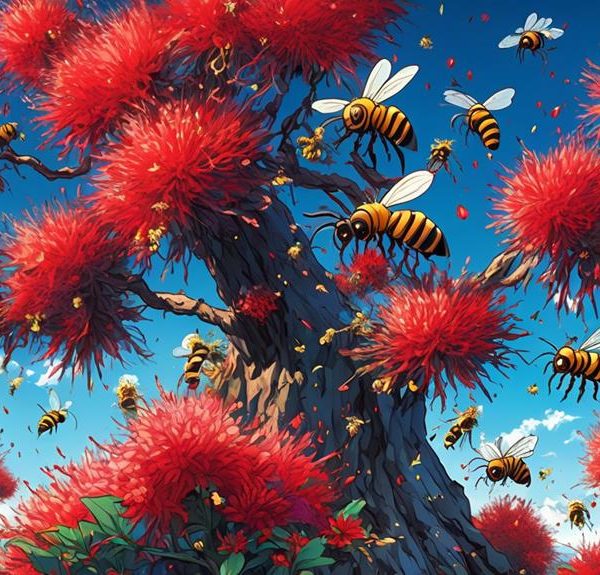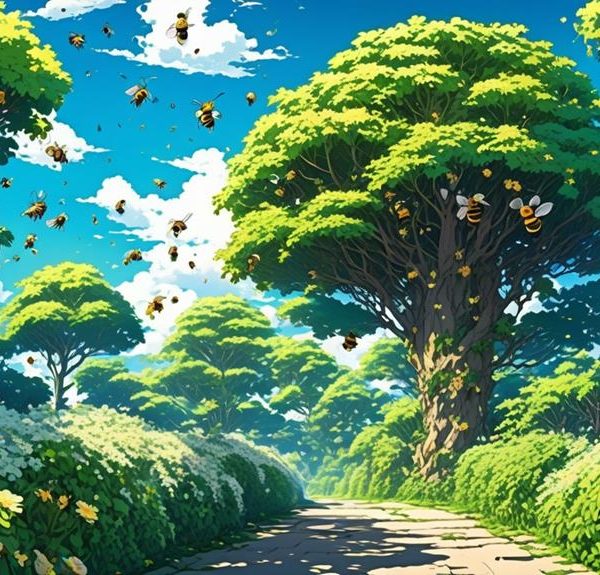Intrigued by the bond between bees and bougainvillea? Delve into this exploration of nature's vibrant symbiosis, leaving no petal unturned.
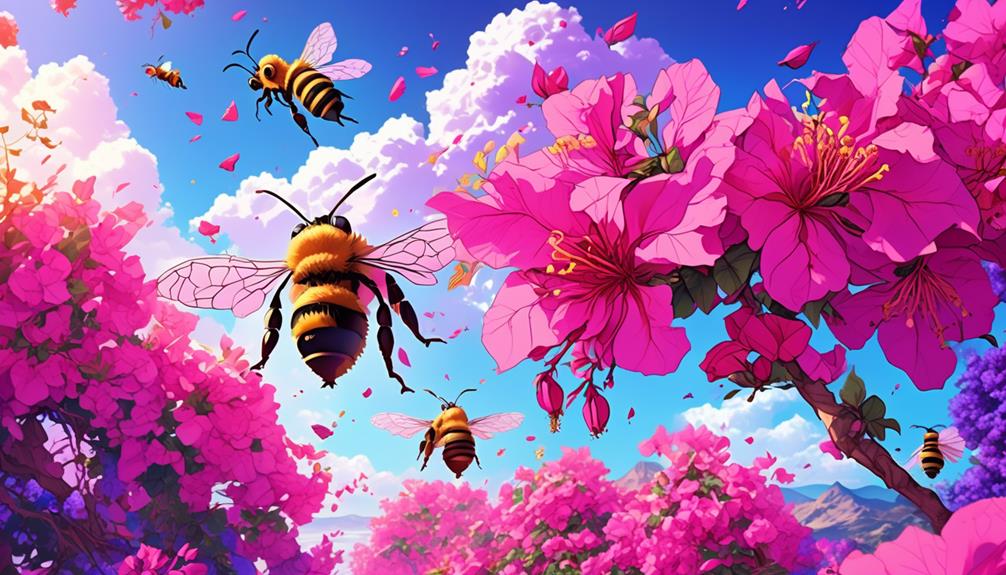
Do Bees Like Bougainvillea
You've probably heard the phrase 'busy as a bee,' but have you ever wondered what really keeps these little workers so occupied?
Well, it's their constant search for nectar, and the types of flowers they're attracted to can be as varied as the bees themselves.
Now, imagine your garden, painted in hues of magenta, purple, and red, with bougainvillea adding a tropical touch. You might be wondering: does this vibrant plant also play host to our buzzing friends?
To answer this, we need to explore the relationship between bees and bougainvillea. So, let's embark on this journey together, and perhaps, by the end, you'll be able to answer the question yourself.
Key Takeaways
- Bees are attracted to the vibrant colors and sweet scent of bougainvillea flowers.
- Bougainvillea offers nectar to bees, which plays a vital role in pollination.
- Bees facilitate the transfer of pollen, promoting a healthy plant population and genetic diversity.
- The interaction between bees and bougainvillea supports wildlife and contributes to the overall ecosystem.
Understanding Bee Preferences
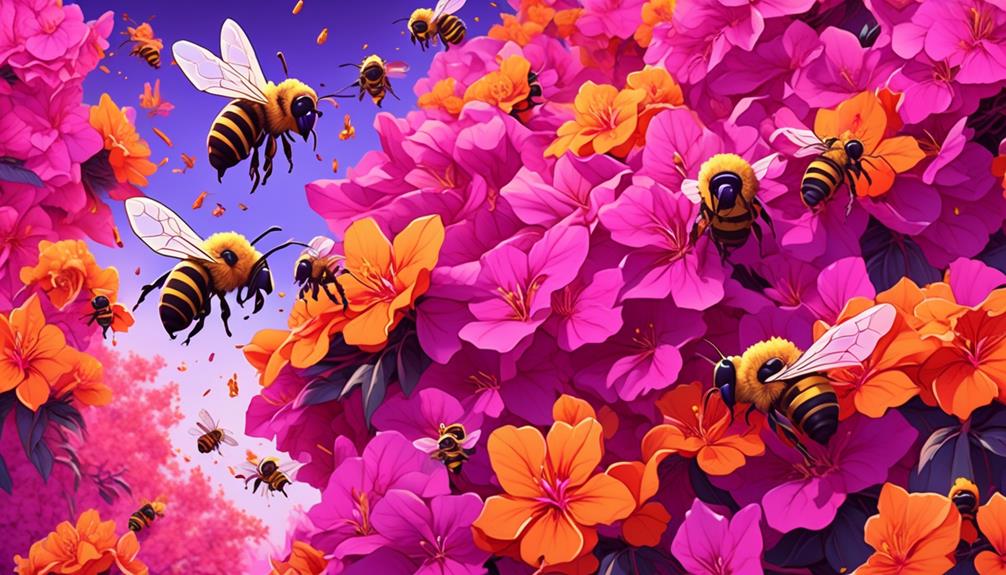
To grasp why bees are particularly drawn to the vibrant Bougainvillea, you need to delve into the intricacies of their flower preferences and the key factors influencing their choices. It's a fascinating blend of science and nature's artistry.
First, consider the bee's vision. Unlike humans, bees perceive the world in a color spectrum shifted towards the ultraviolet. They can't see red hues, but they can see patterns and shapes that we can't, often leading them to flowers that are rich in nectar and pollen. Bougainvillea, with its bright, UV-reflective petals, is particularly attractive to bees.
Next, examine the structure and scent of the Bougainvillea. Bees prefer flowers with landing platforms, and Bougainvillea provides just that with its cluster of tiny flowers surrounded by large, colorful bracts. Additionally, its sweet fragrance is a potent lure for bees, signaling a rich nectar source.
What Attracts Bees?

Understanding what attracts bees requires a detailed look into their sensory perceptions and the unique characteristics of flowers that appeal to them. Bees are particularly drawn to bright colours, especially those in the blue to purple range, and ultraviolet light, which humans can't see. They're also attracted to certain shapes and patterns that suggest a plentiful supply of nectar or pollen.
Scent plays a crucial role too. Bees are equipped with a sophisticated olfactory system, allowing them to detect and remember a wide array of floral fragrances. They're attracted to sweet, fresh, and slightly citrusy scents. However, strong, spicy, or overly sweet scents can deter them.
Temperature is another factor that bees consider. They prefer flowers that are slightly warmer than the surrounding air, which makes them more noticeable. Additionally, the texture of the petals can be a determiner. Bees prefer flowers with a furry or feathery texture, which provides them with a better grip.
Lastly, the availability and quality of nectar and pollen significantly influence a bee's attraction to a flower. High nectar and pollen content are irresistible to bees, making them more likely to revisit these flowers.
Bougainvillea: An Overview

Diving into the world of bougainvillea, you'll find a vibrant, hardy plant native to South America, renowned not only for its colorful, paper-thin bracts but also for its enticing allure to various bee species. This plant, part of the Nyctaginaceae family, thrives in warmer climates and can withstand drought conditions, making it a common choice for landscapes in these areas.
To give you a clearer picture, let's look at some key characteristics and care requirements of bougainvillea in the table below:
Characteristics | Details |
|---|---|
Lighting Requirements | Full sun for best flowering |
Watering Instructions | Allow to dry between watering |
Common Pests | Aphids, scale, and caterpillars |
Bougainvilleas display their beauty in a multitude of shades, from vibrant pinks and purples to fiery oranges and reds. However, it's not the flowers but the bracts – modified leaves – that provide this burst of color. The real flowers are small, white, and inconspicuous. This hardy plant's bloom time is in the warmer months, coinciding with the active period of most bees, providing a valuable source of nectar for these important pollinators.
Bees and Bougainvillea Interaction
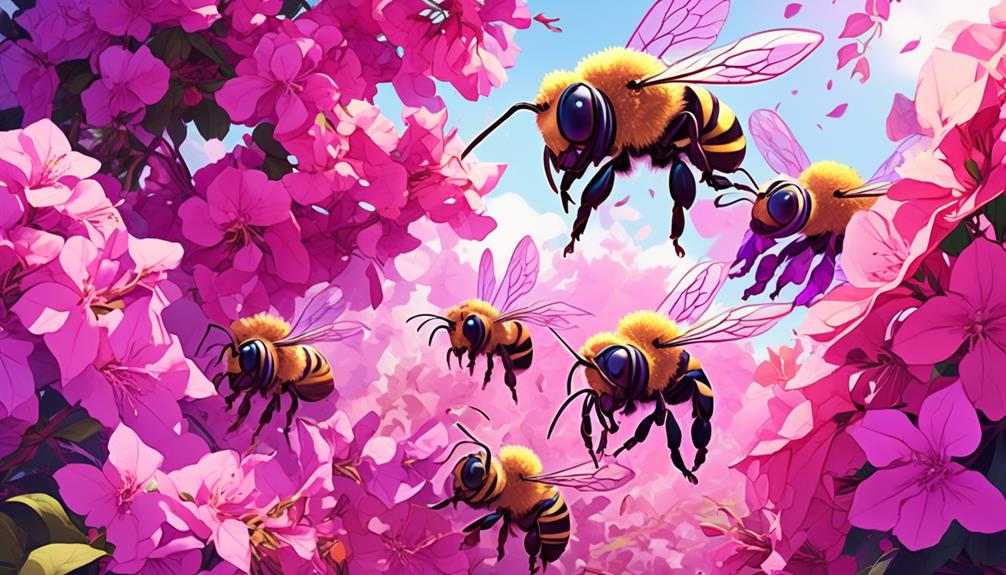
While you're appreciating the vivid hues of bougainvilleas, you'll likely notice the buzzing activity of bees around these plants, signifying a crucial ecological interaction. Bees, as you may know, play a vital role in pollination, a process that's essential for plant reproduction. In this relationship, bougainvilleas offer nectar, and bees, in return, facilitate the transfer of pollen from the male parts of a flower to the female ones.
You'll find it fascinating how this interaction benefits both parties. Bees, particularly honeybees, are attracted to the vibrant colors of bougainvillea flowers. They're also lured by the sweet scent that these flowers emit. As they move from flower to flower collecting nectar, they unknowingly carry pollen grains stuck on their bodies.
For bougainvilleas, this bee activity is crucial. It's their way of ensuring that their pollen reaches other flowers, thus enabling fertilization. Without bees, their reproduction would be significantly hindered.
In essence, the interaction between bees and bougainvilleas is a classic example of mutualism, a symbiotic relationship where both organisms benefit. It's not just about bees loving bougainvilleas, it's also about these plants needing bees for survival.
Impact on the Ecosystem
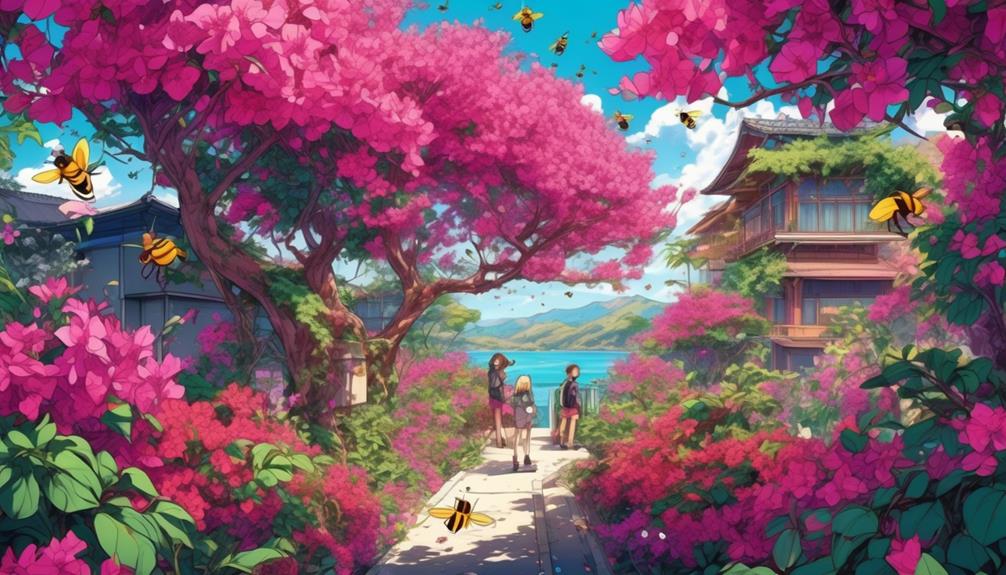
The ecological significance of this mutualistic relationship extends beyond the bees and bougainvilleas, impacting the broader ecosystem in profound ways. You see, when bees collect nectar from bougainvilleas, they inadvertently aid in the plant's pollination. This exchange promotes a healthy, thriving plant population that's vital for biodiversity.
Your garden's ecosystem benefits too. A flourishing bougainvillea attracts more bees, leading to increased pollination of other plants. It's a ripple effect that boosts your garden's overall health and productivity.
However, there's more at stake than just your garden. In their quest for nectar, bees spread bougainvillea pollen far and wide. This helps to maintain the genetic diversity of the species, making it more resilient in the face of environmental changes. It's a small but crucial part of the broader ecological picture.
On a larger scale, bougainvilleas and bees play a role in supporting wildlife. Many creatures depend on bougainvilleas for shelter, while others feed on the insects attracted to these plants. Bees, of course, are a vital part of the food chain, serving as food for various bird species. So, this symbiotic relationship is an essential piece in the complex puzzle of our environment.
Enhancing Bee Attraction in Gardens
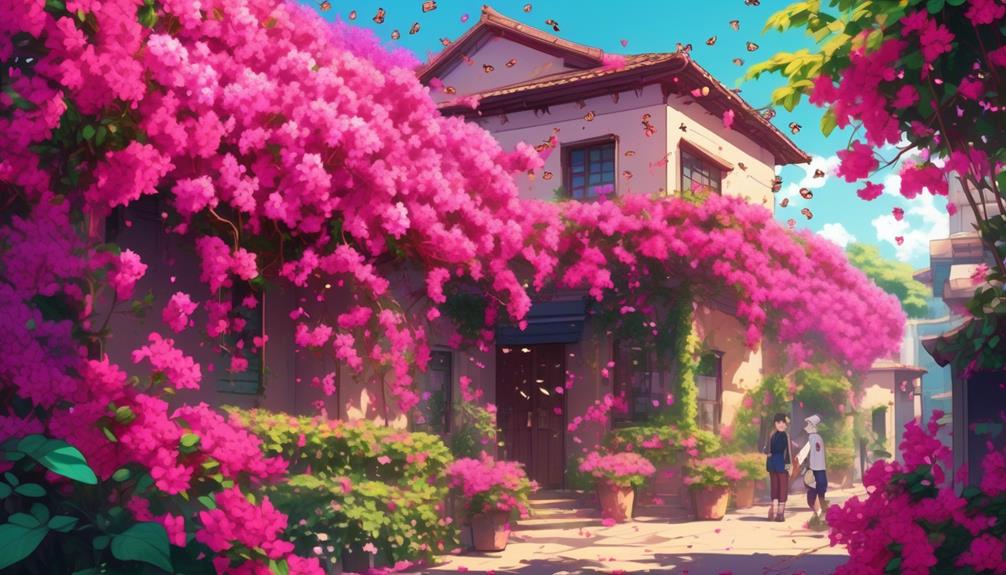
To attract more bees to your garden, you'll need to understand specific aspects of their behavior and preferences that can be influenced by thoughtful garden design and plant selection. Bees are drawn to certain colors, particularly blue and violet, and they prefer plants that produce high volumes of nectar and pollen.
A strategic approach to your plant selection can significantly increase bee visits. For instance, Bougainvillea, with its vibrant colors and abundant nectar, can be a primary attraction for bees.
Here's a simple table that outlines some key considerations:
Garden Aspect | Bee-Friendly Tips |
|---|---|
Plant Selection | Choose flowering plants rich in nectar and pollen, like Bougainvillea. |
Color Scheme | Opt for blue and violet hues which bees find most attractive. |
Garden Design | Cluster same-species plants together, as bees like to 'bulk forage'. |
Frequently Asked Questions
What Other Plants Do Bees Typically Favor Apart From Bougainvillea?
Sure, apart from bougainvillea, bees have a wide range of preferred plants. You'll often find them buzzing around flowers like lavender, sunflowers, and roses. They're also big fans of herbs such as mint, thyme, and basil.
Fruit trees, particularly apple and cherry, are another favorite. Bees prefer these plants as they provide ample nectar and pollen, essential for their survival.
How Critical Are Bees to the Pollination Process of Bougainvillea?
You're right to wonder about bees and bougainvillea. Bees are indeed crucial for bougainvillea's pollination process. They help transfer pollen from the male parts of a flower to the female parts, facilitating fertilization. Without bees, the plant's ability to bear fruit and propagate is severely limited.
How Can I Care for Bougainvillea to Ensure It Attracts Bees?
To ensure your bougainvillea attracts bees, you'll need to provide optimal care. That means plenty of sun, well-drained soil, and a modest amount of watering.
Pruning helps as well; it encourages growth and flower production. Avoid using pesticides, as they can deter bees. Instead, opt for natural pest control methods.
Are There Any Specific Species of Bees That Are More Attracted to Bougainvillea?
You're asking about specific bee species that prefer bougainvillea. There isn't a definitive list, but many common bees, like honeybees and bumblebees, are attracted to this plant. They're drawn to its vibrant colors and the nectar it provides.
Can the Presence of Bougainvillea in My Garden Increase the Overall Bee Population?
Yes, planting bougainvillea in your garden can potentially increase the bee population. It's rich in nectar, which attracts bees.
However, it's not just about planting them, you'll also need to maintain a healthy environment for the bees to thrive. Avoid using pesticides, provide fresh water, and consider adding other plants that bees love.
Conclusion
In conclusion, while bees are drawn to a variety of flowers, they don't particularly favor bougainvillea. Its low nectar and pollen content make it less appealing.
However, it can indirectly contribute to ecosystem health by beautifying landscapes and providing shelter for insects.
To enhance bee attraction in your garden, include more bee-friendly plants that are rich in nectar and pollen.
Remember, bees play a crucial role in biodiversity, so let's make our gardens their sanctuary.

